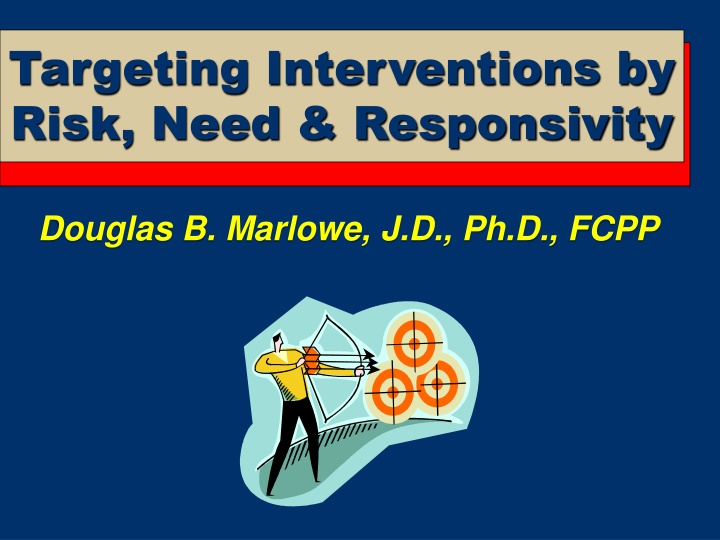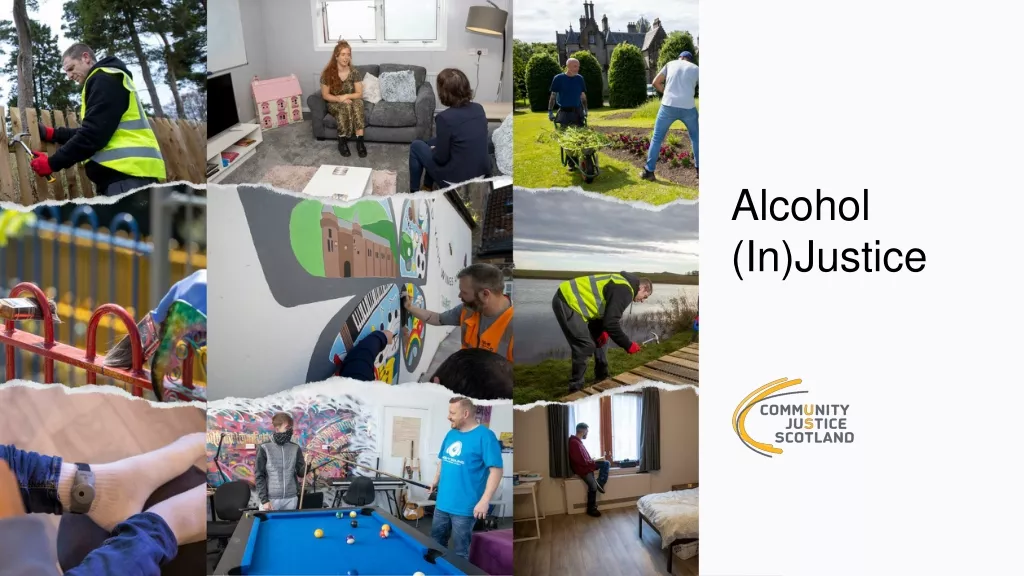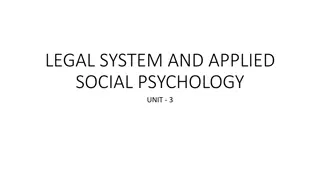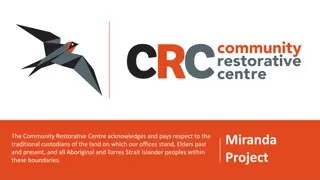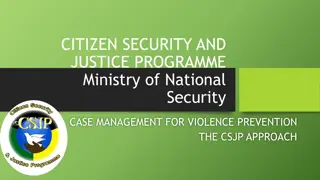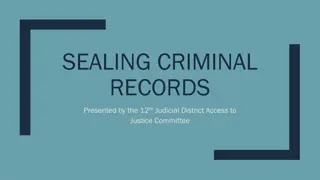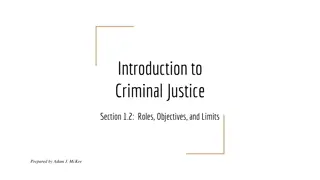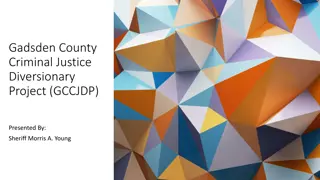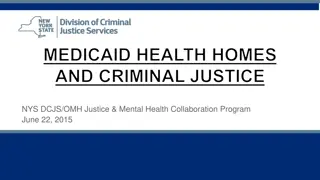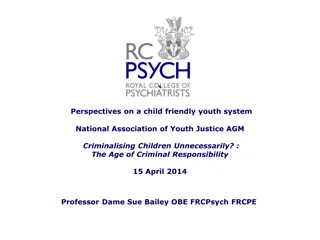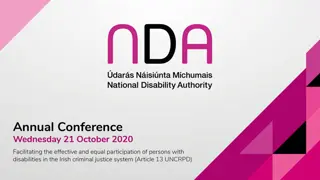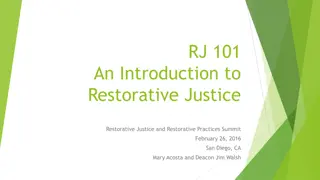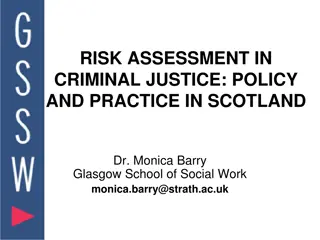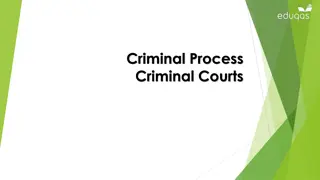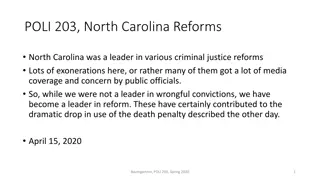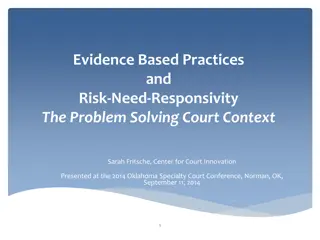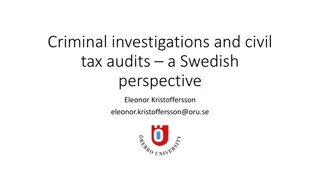Targeting Interventions by Risk, Need & Responsivity in Criminal Justice System
Understanding the Risk Principle, Prognostic Risks, Need Principle, Risk & Needs Matrix, Specific Responsivity, and Case Planning in managing offenders through targeted interventions based on their risk levels, clinical needs, and responsivity to rehabilitation services.
Download Presentation

Please find below an Image/Link to download the presentation.
The content on the website is provided AS IS for your information and personal use only. It may not be sold, licensed, or shared on other websites without obtaining consent from the author.If you encounter any issues during the download, it is possible that the publisher has removed the file from their server.
You are allowed to download the files provided on this website for personal or commercial use, subject to the condition that they are used lawfully. All files are the property of their respective owners.
The content on the website is provided AS IS for your information and personal use only. It may not be sold, licensed, or shared on other websites without obtaining consent from the author.
E N D
Presentation Transcript
Targeting Interventions by Risk, Need & Responsivity Douglas B. Marlowe, J.D., Ph.D., FCPP
Risk Principle Not necessarily a risk for violence or dangerousness Difficult prognosis or lesser amenability to treatment The higher the risk level, the more intensive the supervision and accountability should be, and vice versa Mixing risk levels is contraindicated
Prognostic Risks Current age < 25 years Delinquent onset < 16 years Substance abuse onset < 14 years Prior rehabilitation failures History of violence Antisocial Personality Disorder Psychopathy Familial history of crime or addiction Criminal or substance abuse associations
Need Principle Need Principle Clinical syndromes or impairments (diagnosis) The higher the need level, the more intensive the treatment or rehabilitation services should be, and vice versa Mixing need levels is contraindicated
Risk & Needs Matrix High Risk Low Risk Treatment Treatment Diversion Supervision Treatment Courts (e.g., Drug Courts) High Needs (Pro-social rehabilitation) Treatment Pro-social habilitation Adaptive rehabilitation Adaptive habilitation Supervision Intensive Probation (ISP, HOPE) Secondary prevention Deflection; Banked probation Low Needs Diversion Pro-social habilitation (Adaptive habilitation)
Specific Responsivity Specific Responsivity Order and timing of intervention is crucial: 1. Responsivity needs interfere with rehabilitation 2. Criminogenic needs cause or exacerbate crime 3. Maintenance needs degrade rehabilitation gains 4. Humanitarian needs cause distress 5. Restorative needs e.g., restitution, community svc. Continuing-care plan to address unmet needs Each phase advancement increases the odds of subsequent phase advancements
Case Planning Case Planning Type 1 Case (Dual Diagnosis) 5 phases Stabilization: - Housing assistance - Stabilize cravings, withdrawal, anhedonia - Mental health tx yes Criminogenic: - Addiction treatment - Delinquent peer affiliations - Pro-social regimen; structure - Family crisis mgmt. yes Responsivity Needs? Criminogenic Needs? no no Pro-Social Habilitation: - Criminal thinking - Adaptive problem-solving 18 24 mos. 300 hrs. Maintenance: - Vocational / educational counseling - Life skills training - Therapy / recovery svcs * Restitution; community svc; fees ** HIV/STD prevention ** Overdose prevention & reversal yes Maintenance Needs? Continuing Care no *Restorative justice interventions **Humanitarian Needs
Case Planning Case Planning Type 2 Case (Addiction) 4 phases Stabilization: - Housing assistance - Stabilize cravings, withdrawal, anhedonia - Mental health tx yes Criminogenic: - Addiction treatment - Delinquent peer affiliations - Pro-social regimen; structure - Family crisis mgmt. yes Responsivity Needs? Criminogenic Needs? no no Pro-Social Habilitation: - Criminal thinking - Adaptive problem-solving 12 18 mos. 200 hrs. Maintenance: - Vocational / educational counseling - Life skills training - Therapy / recovery svcs * Restitution; community svc; fees ** HIV/STD prevention ** Overdose prevention & reversal yes Maintenance Needs? Continuing Care no *Restorative justice interventions **Humanitarian Needs
Case Planning Case Planning Stabilization: - Housing assistance - Stabilize cravings, withdrawal, anhedonia - Mental health tx yes Criminogenic: - Addiction treatment - Delinquent peer affiliations - Pro-social regimen; structure - Family crisis mgmt. Type 3 (Socialized) 3 phases yes Responsivity Needs? Criminogenic Needs? no no Pro-Social Habilitation: - Criminal thinking - Adaptive problem-solving ~ 12 mos. ~ 150 hrs. Maintenance: - Vocational / educational counseling - Life skills training - Therapy / recovery svcs * Restitution; community svc; fees ** HIV/STD prevention ** Overdose prevention & reversal yes Maintenance Needs? Continuing Care no *Restorative justice interventions **Humanitarian Needs
Case Planning Case Planning Stabilization: - Housing assistance - Stabilize cravings, withdrawal, anhedonia - Mental health tx yes Criminogenic: - Addiction treatment - Delinquent peer affiliations - Pro-social regimen; structure - Family crisis mgmt. yes Responsivity Needs? Criminogenic Needs? no no Pro-Social Habilitation: - Criminal thinking - Adaptive problem-solving ~ 6 12 mos. < 100 hrs. Type 4 Case: (Situational) 2 phases Maintenance: - Vocational / educational counseling - Life skills training - Therapy / recovery svcs * Restitution; community svc; fees ** HIV/STD prevention ** Overdose prevention & reversal yes Maintenance Needs? Continuing Care no *Restorative justice interventions **Humanitarian Needs
Case Planning Case Planning Stabilization: - Housing assistance - Stabilize cravings, withdrawal, anhedonia - Mental health tx yes Criminogenic: - Addiction treatment - Delinquent peer affiliations - Pro-social regimen; structure - Family crisis mgmt. yes Responsivity Needs? Criminogenic Needs? no no Pro-Social Habilitation: - Criminal thinking - Adaptive problem-solving Type 5 Case: (Deflection) 1 phase ~ 3 mos. ~ 12 - 26 hrs. Maintenance: - Vocational / educational counseling - Life skills training - Therapy / recovery svcs * Restitution; community svc; fees ** HIV/STD prevention ** Overdose prevention & reversal yes Maintenance Needs? Continuing Care no *Restorative justice interventions **Humanitarian Needs
Shaping Behavior Don t expect too much Learned helplessness, ratio burden, ceiling effects Don t expect too little Habituation, complacency Proximal vs. distal goals Phase specificity What was once distal becomes proximal
Treat or Punish? Substance Dependence or Addiction
Treat or Punish? Substance Dependence or Addiction 1. 2. 3. Triggered binge pattern Cravings or compulsions Withdrawal symptoms
Treat or Punish? Substance Dependence or Addiction }Abstinence is a distal goal 1. 2. 3. Triggered binge pattern Cravings or compulsions Withdrawal symptoms
Treat or Punish? Substance Dependence or Addiction }Abstinence is a distal goal 1. 2. 3. Triggered binge pattern Cravings or compulsions Withdrawal symptoms Substance Abuse
Treat or Punish? Substance Dependence or Addiction }Abstinence is a distal goal 1. 2. 3. Triggered binge pattern Cravings or compulsions Withdrawal symptoms } Substance Abuse Abstinence is a proximal goal
Treat or Punish? Substance Dependence or Addiction }Abstinence is a distal goal 1. 2. 3. Triggered binge pattern Cravings or compulsions Withdrawal symptoms } Substance Abuse Abstinence is a proximal goal Collateral needs Dual diagnosis Chronic medical condition (e.g., HIV+, HCV, diabetes) Homelessness, chronic unemployment
Treat or Punish? Substance Dependence or Addiction }Abstinence is a distal goal 1. 2. 3. Triggered binge pattern Cravings or compulsions Withdrawal symptoms } Substance Abuse Abstinence is a proximal goal }Regimen compliance is proximal Collateral needs Dual diagnosis Chronic medical condition (e.g., HIV+, HCV, diabetes) Homelessness, chronic unemployment
Pre-Disposition Assessment Require assessment of risk and need before disposition E.g., as part of a pre-sentence investigation (PSI) Use immunity especially at pre-adjudication stage Valid, reliable, & culturally unbiased instruments Substance abuse vs. dependence diagnosis guides treatment conditions and response to technical violations involving new drug use Automate the if then decisions
